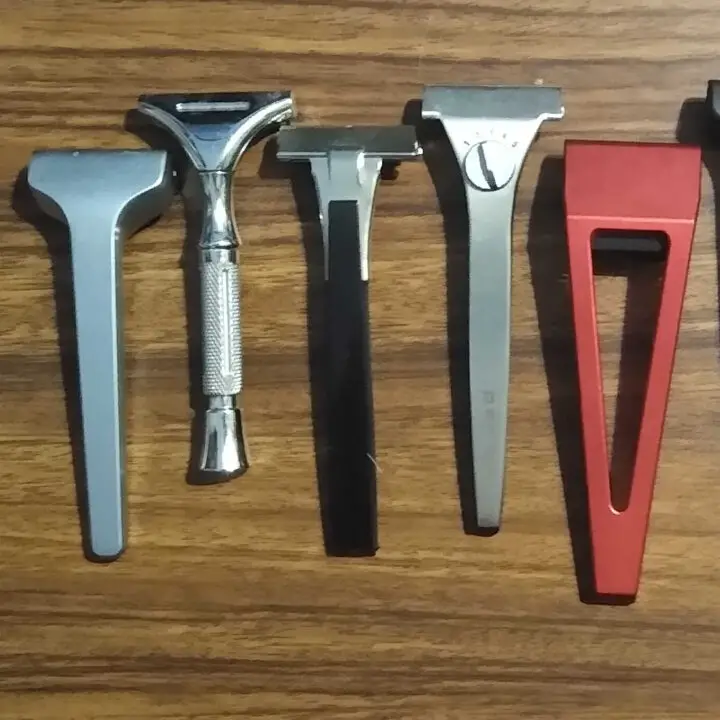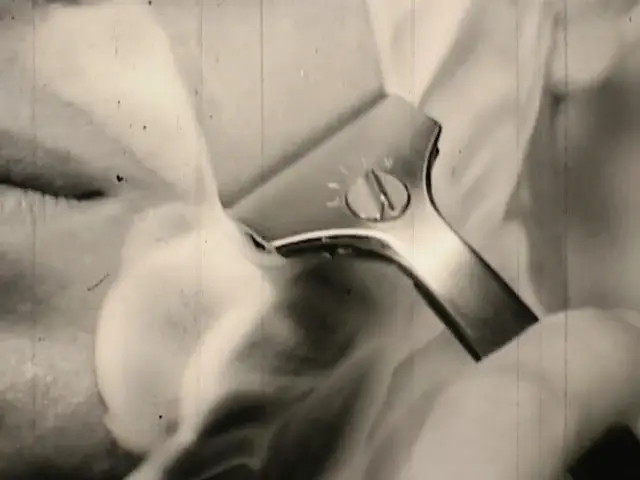
[Editor’s note: this post is a collaboration among several Sharpologist authors. Even though the title of this post says “Comprehensive” we know not every detail is covered. We are looking for additional information on other Injector razors (like the one Gillette made for a while!). We are also looking for images of Injector razors that are not copyrighted: if you have an Injector razor for which we do not have an image feel free to use the Contact Us link to discuss. We’ll be happy to give you credit! ]
The Schick Injector Razor, a seemingly simple shaving tool, boasts a fascinating history of innovation and enduring design. From its early conception to its modern iterations and eventual decline in mainstream retail, the Injector razor has left a significant mark on the world of shaving. This post delves into the rich history of this iconic razor, tracing its evolution through design changes, model variations, and the various companies that have championed its unique mechanism.
The Genesis: From Repeating Firearms to Shaving Innovation
The Injector story begins with Colonel Jacob Schick, an American inventor and entrepreneur inspired by the mechanics of repeating firearms. Dissatisfied with the safety razors of his time, which often required direct handling of sharp blades, Schick envisioned a system where blades could be loaded and unloaded safely and efficiently. This led to the founding of the Magazine Repeating Razor Company in 1926.
Schick’s first creation was the Magazine Repeating Razor (Type A), produced from 1926 to 1927. This groundbreaking razor was designed “to use the principles of repeating firearms in a safety razor not much larger than a good-sized fountain pen”. It featured a folding head and an alloy tube handle with eight grooves and a vented cap, and it came with a magazine of blades that could be loaded without touching the sharp edges.
Following the initial success, Schick introduced The New Schick Razor (Type B), which was produced between 1927 and 1932. This model came in three variations, including silver-plated, gold-plated, and sterling silver handles, with different packaging and guard designs. These early razors showcased Schick’s innovative approach to blade loading and safety.

The Simplified Schick Automatic Razor (Type C) followed, manufactured from 1933 to 1941. This model featured a simplified loading mechanism that eliminated the need for a difficult spring plug and came with open comb, closed comb, or bar guards.
The Birth Of The Injector: A New Era In Blade Loading
The pivotal moment arrived in 1935 with the introduction of the first razor explicitly named the Schick Injector Razor (Type D) by the Magazine Repeating Razor Co. This razor marked a significant design shift, utilizing an external blade injector to load fresh blades into the razor head without direct contact. The head of the Type D could also be opened for cleaning, and it featured a traditional head with a flat square spring. Its handle was a distinctive scissors-type split metal, gold-plated design.
Also introduced in 1935 was the Schick Injector Razor Deluxe Model (Type E). This model was the first to feature an amber Bakelite handle, a material that would become strongly associated with vintage Schick injectors. The Type E saw variations in the head spring design (flat with tabs in early models, later round with flaps) and guard design. Its packaging also varied, including black Bakelite boxes and cardboard options.
Jacob Schick sold his interest in the Magazine Repeating Razor Company in 1928 to focus on his next major invention: the electric shaver. However, his initial designs and patents laid the groundwork for the enduring success of the injector razor.
The Eversharp Years: Ownership Changes, Competitors, and Design Refinements

In 1946 the Eversharp Co. acquired the intellectual property rights to the Schick Injector Razor. During this period, the company experimented with branding, initially using names like Eversharp Schick Injector Razor, with the “Eversharp” often emphasized over “Schick Injector.” However, the enduring recognition of the Schick name eventually led to its prominence.
In 1953 American Safety Razor acquired the Pal Blade Company, gaining the PAL, Treet, and Personna brands. Initially PAL produced an Injector-compatible blade, but by the mid-50’s and into the 60’s also produced Injector-style razors, including an adjustable Injector razor made with stainless steel.
(The acronym “PAL” in the context of a razor, specifically a “PAL Adjustable Injector Razor,” doesn’t stand for anything specific, but rather it’s a brand name.)
In 1965 Schick Safety Razor Co. became a division of Eversharp.

The Eversharp era saw the introduction of several models, including the Type G (1946-1955), which featured molded plastic or metal handles in various finishes and colors. The Fashion Razor (Type H, 1947-1953) was specifically marketed to women and featured a compact, flat travel style with a cap.

A significant design change occurred with the introduction of the Schick Injector Razor (and Hydro-magic) Type I (1955-1958). This model featured the first major change in 20 years, incorporating a triangular flat spring. The Hydro-magic lever, found on some Type I and later models, allowed the user to loosen the cap and guard for rinsing the blade without touching it.
The Type J (1958-1964) resembled the Type I but featured a longer, round handle. Notable variations included the Golden 500 and Schick 500, both with the Hydro-magic lever. The Lady Eversharp Beauty Razor (Type K, 1962-1968) also featured a long round handle with different finishes and the Hydro-magic lever.

Warner Lambert and Beyond: Modernization and Market Shifts
In 1969, Eversharp sold the Schick Safety Razor Company to Warner Lambert Company. Under Warner Lambert, the injector razor continued to evolve. The Type L (1965-1980) saw various handle designs, including the Smooth back, Stick Schick (with a gearshift lever handle), Schick Grip (tennis racquet handle), and the Schick II, a twin-blade injector.
The Schick Dial Injector Razor (Type M, 1965-1972) introduced a new feature: a blade adjustment knob, allowing users to customize their shave. PAL offered a similar razor made of stainless steel.
A further design change occurred with the Type N (1980-1998), which featured a T-shaped head and a flat, narrow spring. Handle designs included options with chrome accents, plain black, and rubber grips.
Ownership continued to shift. Warner Lambert was bought by Pfizer in 2000. The Type O (1999-early 2000’s), under Pfizer Warner Lambert, featured a stainless steel handle integrated into the head and black rubber grip strips. Notably, around 1998, in-store sales of the injector razor were terminated in North America, though they remained available online and in markets like Japan.
(In 2003, Pfizer sold Schick to Energizer. Finally, in 2015, Energizer spun off its personal care division as Edgewell Personal Care, which currently owns the Schick brand. While the Schick Injector Razor’s long production run has ended, its legacy remains.)
Collector’s Corner
While the Schick Injector Razor was a mass-produced item and common models don’t command high prices, certain variations are more sought after by collectors. These include razors with unusual handle materials, precious metals, short production runs, intact packaging and paper, and special offers or promotions. Early models like the sterling silver Magazine Repeating Razors are particularly valuable.
The “Modern” Injector Era
[Note: Supply links are affiliate.]

The Injector niche’ remained dormant until about 2015 when the company that would become Supply launched a crowdfunding campaign for a new Injector-style razor made of stainless steel. That razor would become the Supply Single Edge razor in 2018. The main feature of the razor was interchangeable base plates, offering a range of shave aggressiveness.
Since that time Supply has updated the razor several times and now offers the Supply “SE” razor, continuously adjustable razor, the Supply Pro, and most recently a disposable version of the SE.
More recently several other Injector-compatible razors have arrived on the market. The Hype X1 was launched in 2023 and, like the Supply Single Edge, offers interchangeable base plates.
The Parker continuously adjustable Injector razor was also launched in 2023.
Conclusion: An Enduring Design
The history of the Schick Injector Razor is a testament to the ingenuity of its initial design and the enduring appeal of its safe and convenient blade loading mechanism. Despite numerous ownership changes and the eventual shift towards cartridge razors, the Schick Injector has maintained a dedicated following for decades. From Colonel Schick’s vision of a safer shave to the subtle design refinements by subsequent manufacturers like Eversharp and Warner Lambert, the injector razor stands as a significant chapter in the evolution of shaving technology. While its presence in retail stores may have diminished, the legacy of the “ingenious injector” continues to resonate with shaving enthusiasts worldwide.

I started with double edge razors but now I rarely use them. My preferred razors include Supply, a couple of old Schicks, a Cobra classic, OneBlade and Feather Artist Club DX. My beard is very difficult to cut (especially around the mouth and chin) and single edge blades do a much better job than DEs.
Great history lesson, folks! I purchased a Supply SE over a year ago and it’s been my daily driver ever since. Add their new Premium blades to the mix and one has a winning combination on their hands. Highly recommended!